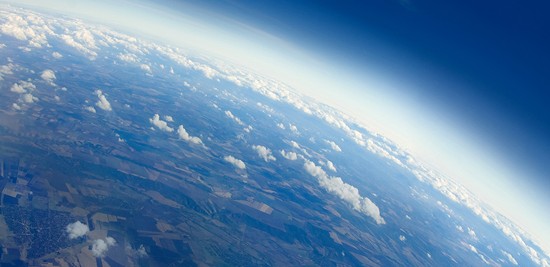When we talk about climate change modelling, most of the science looks at changes in the troposphere, the breathable lower atmosphere. The majority of the physical atmosphere, however, lies beyond the troposphere.
Our planet’s atmosphere is a multi-layer cake. Here’s a quick summary of its many layers.
- Troposphere – extending 12 kilometres (7.5 miles) above the Earth’s surface where life is found in abundance.
- Stratosphere – extending to 50 kilometres (31 miles) above the surface and the home of the ozone layer.
- Mesosphere – extending to 80 kilometres (50 miles) and the planet’s coldest place with average temperatures at -85 Celsius (-120 Fahrenheit) and the home of noctilucent clouds often mistaken for UFOs.
- Ionosphere and Thermosphere – extending to 700 kilometres (440 miles) above the Earth with the ionosphere at the lowest layer. It is the home of the auroras that light up the poles and also home to the International Space Station (ISS) which orbits in the thermosphere.
- Exosphere – extending to 10,000 kilometres (6,200 miles) above the planet where it merges with the solar wind.
- Magnetosphere – not always referred to as an atmospheric layer and extending to 60,000 kilometres (37,000 miles) on the side facing our Sun and a magnetotail trailing 300,000 kilometres (186,000 miles) on the side away from our home star, the home of Earth’s protective magnetic field.
- Geocorona – only recently discovered and extending to 629,300 kilometres (391,000 miles) and consisting of clouds of hydrogen atoms that go beyond the orbit of the Moon.
Other than the troposphere, do any of these other layers contribute to climate change?
The latest research paper coming from the University of East Anglia in the United Kingdom, notes changes to the stratosphere may need to be better understood when doing climate models. The issue brought to light by the paper addresses the water vapour content of the air lying between 15 and 50 kilometres (9 to 31 miles) above the Earth.
The stratosphere is bone dry. The average amount of water vapour contained within it amounts to between 3 and 5 parts per million (PPM) globally. That compares to 10 PPM in the troposphere’s coldest areas and up to 50,000 PPM in the humid tropics. Water vapour enteris the stratosphere from the troposphere and with climate change amplifiers it remains not well understood how this could affect climate and the all-important ozone layer.
A paper from East Anglia which appears in the journal Nature Geoscience, considers the potential for stratospheric water vapour volumes to increase by as much as 25% per each degree of warming in the troposphere. Current climate models show seasonal changes happening to water vapour in the stratosphere with trending to higher amounts over the longer term.
In an effort to understand the impact of water vapour in the stratosphere, the paper provides a statistical model based on observational data to project the future under different climate change scenarios. The statistical model shows that observational data and some climate models that show large changes to stratospheric water vapour are incorrect.
Professor Manoj Joshi, a co-author of the East Anglia paper notes in a university communications release that “Our research implies that while stratospheric water vapour concentrations are still likely to increase with global warming, the large changes that could substantially delay ozone recovery are highly unlikely.” This at least is one piece of good news about the impacts of anthropogenic climate change on our planet.
















